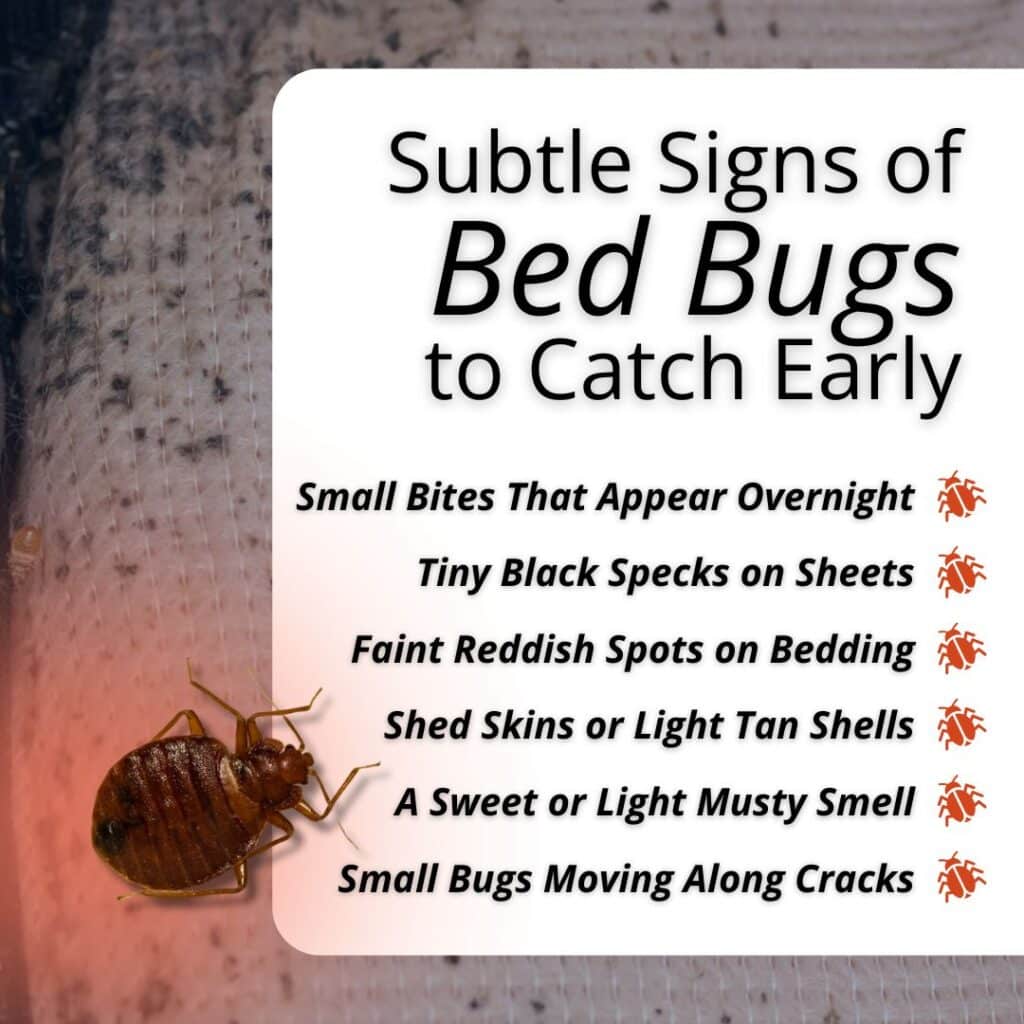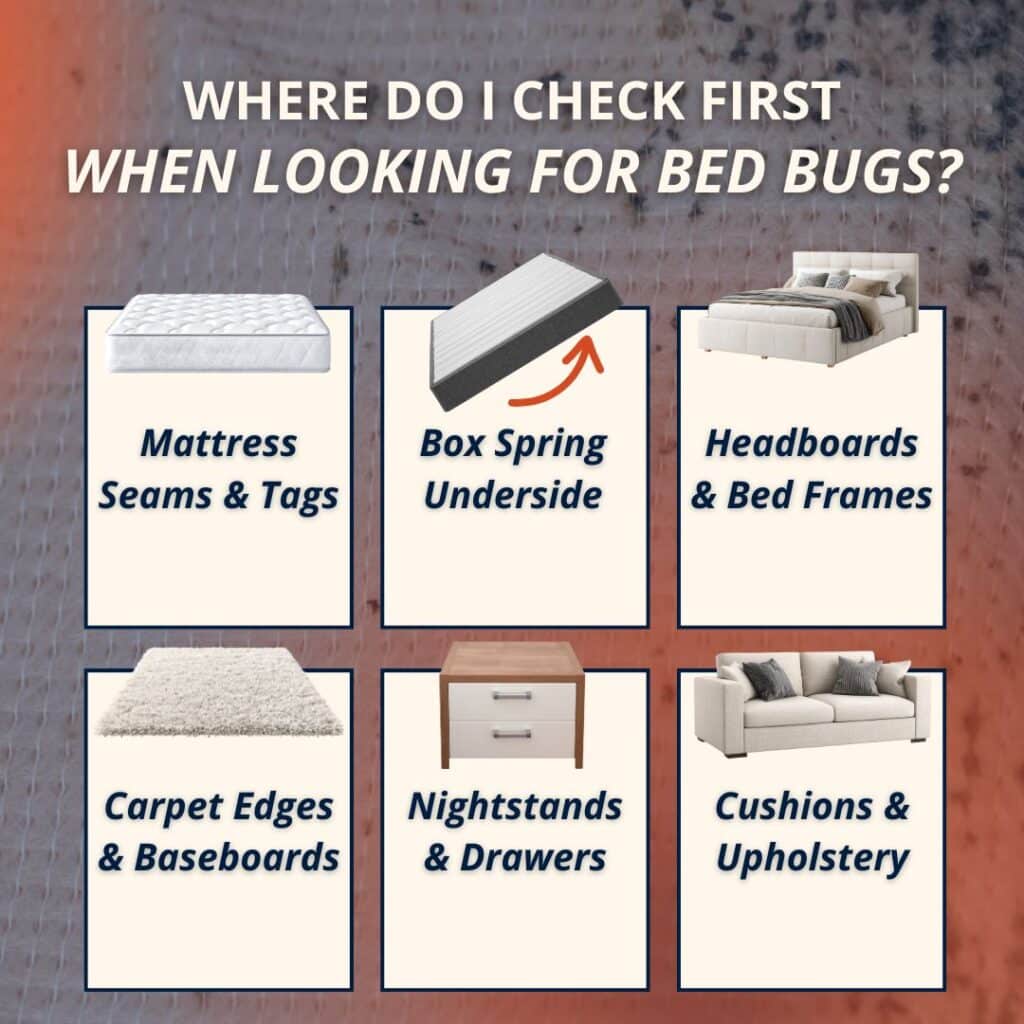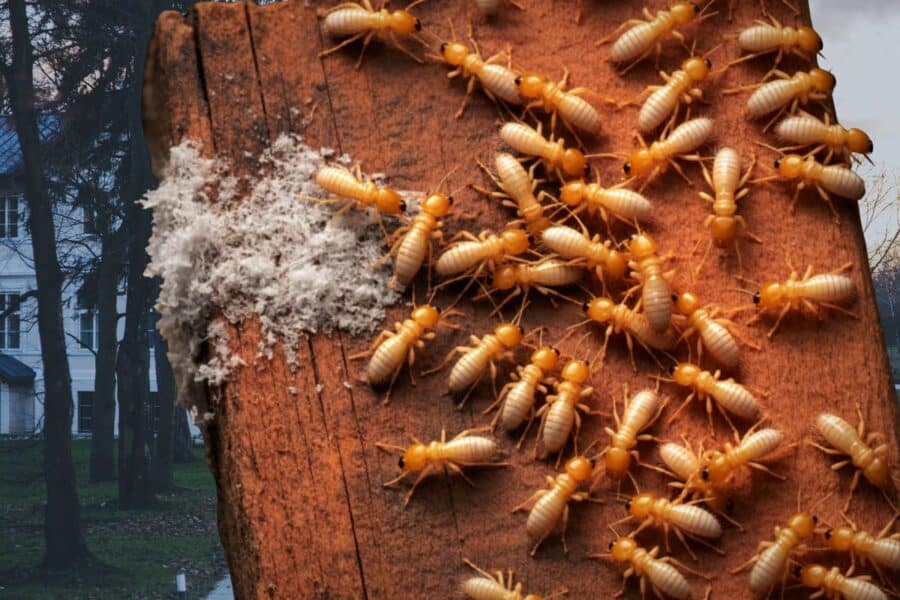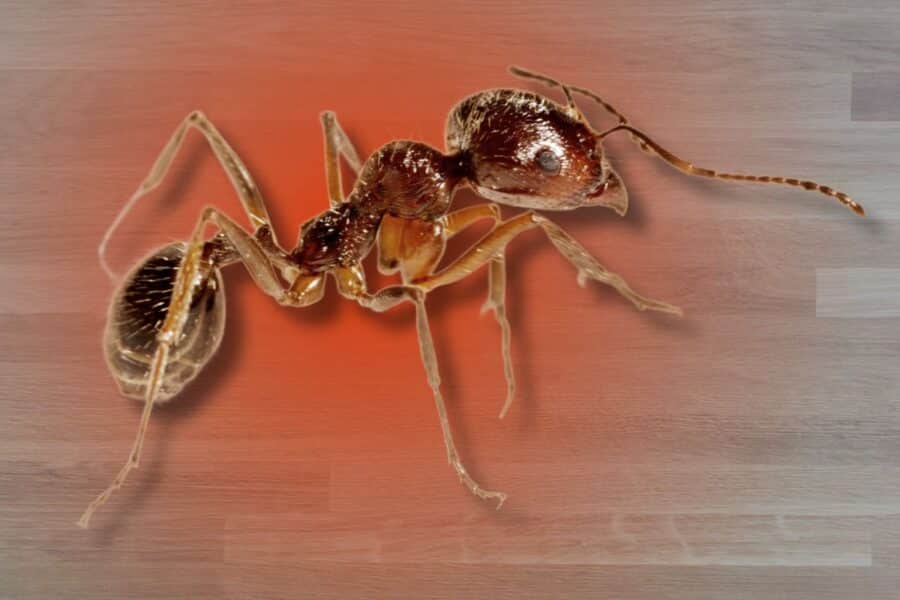Bed bugs spread fast, especially in Texas, where it’s warm and humid. Most homeowners do not see the bugs first. They see small changes in bedding, bites, or movement around seams. These early signs appear long before an infestation of bed bugs becomes obvious.
The clues often show up weeks before anyone sees a live bug crawling.
This guide explains what early activity looks like, where bed bugs hide during the first stages of an infestation, how to confirm the problem, and when to bring in a professional.
Why Bed Bugs Spread So Quickly in Texas
Bed bugs grow faster and spread more easily in warm climates. Areas like Conroe, Spring, and The Woodlands see long warm seasons, which speeds up bed bug development.
Texas A&M research shows that heat shortens the time between feedings, egg laying, and molting, which means a small population can grow into a larger group quickly.
Other factors that help them spread:
- Carpeted bedrooms with warm, sheltered edges
- Regular travel between Houston and local suburbs
- Multi-level homes with many hiding places
- Shared furniture, secondhand purchases, or visiting guests
Because bed bugs move quietly and hide well, early detection is one of the best ways to prevent a larger infestation.
The First Signs of Bed Bugs Most People Notice
Many early signs are small and easy to overlook. Once you know what to look for, these clues become easy to spot.

1. Small Bites That Appear Overnight
Small, itchy bites are one of the first indicators. They often appear:
- In clusters
- In a loose line
- On exposed skin areas like arms, legs, shoulders, or the back
The CDC notes that bite reactions vary widely. Some people show red welts. Others show small bumps. Some show no reaction at all.
Because of this, bites alone do not confirm a bed bug problem but are a strong reason to investigate further.
2. Tiny Black Specks on Sheets
Small black dots are often bed bug droppings. They resemble pepper flakes and smear when touched with a damp cloth. They often appear:
- Along mattress seams
- On the corners of sheets
- Around pillow edges
- Near the headboard
Most homeowners notice these spots before they ever see a live bug.
3. Faint Reddish Spots on Bedding
Light red or rusty stains can come from crushed bugs or small feeding marks. These stains:
- Are small
- May appear near the top of the bed
- Often show up near pillow areas
Finding one or two does not confirm an infestation, but repeated stains are a common sign.
4. Shed Skins or Light Tan Shells
As bed bugs grow, they shed their outer skin several times. These shells are:
- Thin
- Pale yellow or tan
- Often found in clusters
They appear in:
- Mattress corners
- Box spring edges
- Baseboards
- Drawer corners
- Bed frame joints
One shed skin can indicate early activity. Multiple skins point to a growing population.
5. A Sweet or Light Musty Smell
Some early infestations create a mild sweet or musty scent. It is usually strongest in:
- Closets
- Corners of bedrooms
- Upholstered beds or headboards
- Rooms with limited airflow
The smell grows stronger as the infestation spreads, but sensitive homeowners may notice it early.
6. Small Bugs Moving Along Seams or Cracks
Bed bugs are small, flat, and slow-moving. In early stages, they often appear only when:
- A pillow is lifted
- A mattress is shifted
- A bed frame is bumped
- A drawer is opened
They hide in tight areas, and early sightings usually mean there are more bugs nearby.
Where Bed Bugs Hide Most
Bed bugs rarely start in open spaces. They prefer warm, sheltered areas close to where people rest or sit.
Mattresses and Box Springs
Common hiding spots:
- Mattress seams
- Under tags or labels
- In the piping around the edges
- On the underside of the box spring
These areas stay warm and dark, which makes them ideal early-stage hiding places.
Headboards and Bed Frames
Upholstered headboards are one of the first places bed bugs gather. They settle:
- Under fabric layers
- Along stitching
- Behind the headboard against the wall
- In wooden frame joints
Many infestations start here before spreading to bedding.
Baseboards and Carpet Edges
Carpeted bedrooms create perfect hiding lines. Bed bugs hide:
- Along the baseboard
- Where carpet meets the wall
- Behind peeling paint
- Near electrical outlets
Carpet warmth and low airflow help them settle quickly.
Nightstands and Small Furniture
Nightstands hold heat and provide quiet shelter. Bugs hide:
- Under drawer bottoms
- In drawer slides
- Behind back panels
Even one shed skin inside a drawer can indicate activity.
Couches and Upholstered Furniture
If someone naps on the couch, sits there often, or brings bags inside, bed bugs can establish a second hiding spot.
Look at:
- Cushion seams
- Under cushions
- Behind fabric edges
- Under the furniture frame
Activity in living rooms usually means the infestation is spreading beyond the bedroom.

Why Early Detection Matters
Early detection helps contain bed bugs to one room before they spread to more spaces. A small, early infestation is easier and faster to treat.
Catching bed bugs early prevents:
- Bugs spreading through clothing or bags
- Larger populations forming in multiple rooms
- Higher treatment costs
- Longer preparation and cleanup
- Stress and sleep disruption
Texas A&M reports that a female bed bug can lay several eggs per day during warm seasons. Even a small group can grow quickly.
How Professionals Confirm a Bed Bug Problem
Grand Slam Pest Control uses a detailed inspection method to find bed bugs even at the earliest stages.
Step 1: Detailed Visual Inspection
Technicians check the most likely hiding areas:
- Mattress seams
- Box springs
- Bed frames
- Upholstered furniture
- Baseboards
- Adjacent rooms
They look for shells, stains, eggs, and live bugs.
Step 2: Flashlight and Gap Check
Bed bugs hide in the smallest cracks. Professionals inspect:
- Trim lines
- Screw holes
- Electrical outlet areas
- Curtain rods
- Carpet edges
This often reveals bugs that homeowners did not know were there.
Step 3: Activity Level Assessment
Professionals assess whether activity is:
- Early
- Moderate
- Large-scale
- Localized or widespread
This helps guide treatment recommendations.
Step 4: Treatment Plan
Grand Slam creates treatment plans based on Texas conditions. Plans may include:
- Heat-based methods
- Targeted chemical treatments
- Follow-up visits
- Prevention guidance for future protection
The goal is to remove both live bugs and hidden eggs.
Other Common Questions from Homeowners
Do bites always mean bed bugs?
Not always. Mosquitoes, fleas, and even certain mites can leave similar marks. Pest professionals look at patterns, locations, and other clues to narrow down the source.
Could attic or wall pests lead to nighttime noises or movement?
They can. Rodents or wildlife inside walls may cause rustling or tapping sounds that some homeowners confuse with bed bug activity. A full pest inspection helps sort out which issue is present.
Do moisture problems attract other indoor insects?
Yes. Damp rooms can draw in ants, roaches, and other pests that thrive in humid areas. If moisture is present in the bedroom or hallway, an inspection may be recommended to identify related issues.
When to Call a Professional
You should contact a pest control professional when:
- You see even one confirmed bed bug
- You find recurring bites without a clear cause
- Stains or skins appear on bedding or furniture
- You recently traveled or had overnight guests
- You spot activity in more than one room
- The smell in the bedroom seems strange or musty
- Someone in the home is reacting strongly to bites
Early professional inspections prevent the problem from growing and spreading.
Conclusion
Small clues like bites, stains, shed skins, or light movement along seams are often the first signs of bed bugs in Texas homes. These pests thrive in warm, humid climates and hide in tight spaces, which makes early detection important.
When caught early, bed bug problems are much easier to control and far less disruptive.
Grand Slam Pest Control helps homeowners across Conroe, Spring, and The Woodlands identify bed bug activity quickly and choose the right treatment.
Schedule service today with experienced technicians who are ready to stop the problem early and protect your home.


